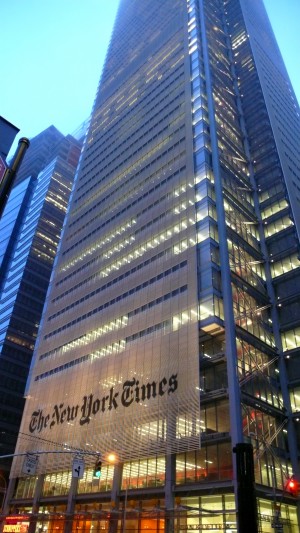Because lighting accounts for approximately 39 percent of the average commercial office building’s total electricity use, effectively managing lighting use gives high-rise building owners and facility managers the power to save more electricity than they can with any other control technology at their disposal – without sacrificing employee comfort or satisfaction.
Total Light Management (TLM) Systems
One way to efficiently manage lighting is through a TLM system. TLM systems maximize the use of electric light and daylight to simplify operations, reduce operating costs, and save up to 65 percent of lighting energy … all while improving productivity. A TLM system can result in greater lighting energy and HVAC efficiencies, ultimately creating a more flexible and productive space.

Designed to use 1.28 watts of lighting power per square foot, the New York Times Building implemented TLM and is now using approximately 0.40 watts of lighting power per square foot – savings of about 70 percent.
By choosing a digital TLM system, lighting and shading zones can be reconfigured without rewiring, making a space adaptable and responsive in high-churn situations that are common in high-rises. As the needs of a space change, sensors and controls can be reassigned to different fixtures or groups of fixtures without disrupting workflow. Additional efficiencies can be realized by choosing a lighting control system that enables integration with other building management systems via BACnet IP communication.
Benefits of TLM
In addition to saving energy, there are several other benefits to think about when considering a TLM system.
- An increase in productivity and comfort by allowing occupants to adjust lighting levels to suit personal preferences.
- Financial savings by reducing operating and maintenance costs.
- Creation of a more flexible space with adjustable lighting and shade levels.
- Enhancement of other systems’ efficiency levels (reducing lighting energy use by 3 watts consequently decreases HVAC usage by 1 watt).
- LEED points contribution, qualifying for rebates, and compliance with new codes.
Challenges of TLM
As systems evolve, IT and facilities management staff are being tasked with monitoring and reporting energy usage and savings, as well as being able to offer recommendations for enhancing building performance.
The shift to intelligent buildings and software-based systems creates tremendous opportunities for building efficiency, but it also creates new challenges. If TLM is something you’re considering for your facility, you should note that TLM can also bring a host of other possibilities:
- Convergence of IT and facilities management to ensure proper system function.
- Integration of multiple building systems into a “single pane of glass” that provides a single access point to building system infrastructure.
- A need for more effective data analysis, aggregation, and visualization, including using data from lighting systems for other purposes like space planning, HVAC optimization, and security.
- Continuous commissioning.
- Preparation and planning for the evolving smart grid.
TLM System Application
TLM systems can be used to control a single space, small area, entire floor, whole building, or even an entire campus. By choosing a flexible, versatile, and expandable system, TLM can be ideal for offices, education, healthcare, hospitality, and virtually any other type of high-rise, including new construction and retrofit projects.
Designed to use 1.28 watts of lighting power per square foot, the New York Times Building implemented TLM and is now using approximately 0.40 watts of lighting power per square foot – savings of about 70 percent. The Empire State Building project has estimated a 60-percent savings in lighting energy from various lighting management strategies; it expects a payback of less than three years for TLM. At Reading Area Community College in Reading, PA, stairwell lighting retrofits are delivering lighting energy savings of between 80 and 82 percent as a result of lighting control solutions.
Using a TLM strategy can make your high-rise work harder, support intelligent control systems, and incorporate energy-efficient lighting control that can be easily designed, installed, and reconfigured to meet the changing needs of your building.
Photo Credit: Renzo Piano
Originally published January 18, 2013
Matt Ochs
Matt Ochs is the commercial system product manager for Lutron Electronics.

